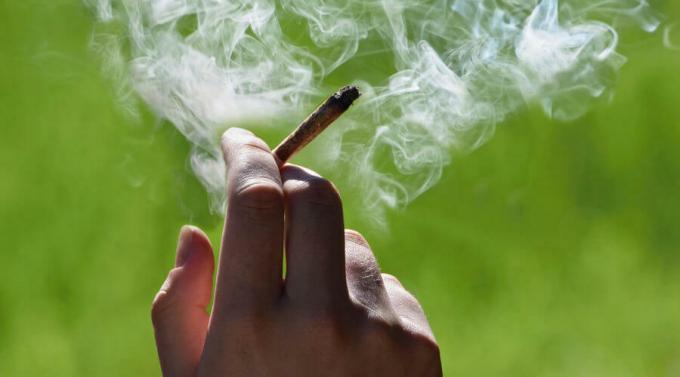THE marihuana (cannabis sativa) is, without a doubt, one of the most controversial drugs today. This is due to the fact that, despite having recreational use and presenting damage to the organism, this plant has components that have medicinal importance, being, therefore, a plant that deserves attention.
→ How is marijuana used?
Marijuana is a plant of familyMoraceae widely used all over the planet, being considered the most used illicit drug in the world. Its consumption, when compared to other permitted drugs, is second only to alcohol and cigarettes.
The main form of administration of marijuana is the inhalation (smoked), a method that leads to a quick effect on the body. It is estimated that in about half an hour, marijuana will reach its maximum levels in the user's blood. In addition to inhalation, many people use marijuana by ingesting it.
According to the National Secretariat for Drug Policy, in the booklet on marijuana, cocaine and inhalants, for every 100 Brazilians, approximately 9 have used marijuana at least once in their lives. |
→ Is marijuana bad?
Marijuana can cause damage to the body, especially when the user uses a large amount and for a long period of time. The increasing abuse of this substance is related to the fact that many believe it is of a natural product and therefore it does not harm or even that marijuana is a drug considered Light.
Do not stop now... There's more after the advertising ;)
Read too:What is natural doesn't hurt?
It is important to note that marijuana causes both short-term and long-term changes in the body. Below, we have a chart with the most common effects of marijuana in the short term, however, it is very important to highlight that these effects are those most commonly reported, not being observed, therefore, in all people who use the marihuana.
The effects are directly related to how the drug was used, the amount used and how the body responds to the drug.
ACUTE EFFECTS OF THE USE OF marijuana |
Changing the perception of time and space |
increased heart rate |
Increased appetite |
Dry mouth |
Mental confusion |
Exacerbation of existing psychotic symptoms |
red eyes |
Panic |
loss of inhibition |
Reduced motor capacity |
memory reduction |
Feeling relaxed or euphoric |
heightened senses |
Although many effects wear off shortly after use, some of these effects are dangerous. Changes in the individual's perception, for example, can put them at risk by increasing the chances of putting them in dangerous situations, which the person would not normally be subject to.
Driving, for example, can be quite dangerous, as the drug alters the perception of time and space. In addition, another point to be considered is the loss of inhibition, which can, for example, lead the individual to engage in risky sexual behavior.

Marijuana use can have both short-term and long-term effects.
As stated earlier, over time, the use of marijuana can also bring effectschronic, which can be very serious. It is believed that the negative impacts are greater on the individual when he starts using the drug very early and uses it for a long time. The table below reports some of these chronic manifestations:
CHRONIC MANIFESTATIONS OF THE USE OF marijuana |
cognitive alterations |
Bronchitis |
Lung cancer |
Schizophrenia in vulnerable individuals |
Psychosis in vulnerable individuals |
Ammotivational syndrome (characterized by a state of social isolation, passivity, apathy and indifference) |
It is also worth noting that marijuana can have a negative effect when used by women who are pregnant women. Some studies suggest that the use of this plant may increase the risk of developing babies with anencephaly and children with disorderscognitive.
Read too: Krokodyl
→ Marijuana addictive?
Marijuana is a drug that yes it can cause addiction, however, this does not mean that all people will experience this problem. The addiction caused by marijuana is characterized by a need for its effects after its use is discontinued. The person may feel agitated, restless, irritable, have difficulty sleeping, and also experience symptoms such as cramps and nausea.
→ Marijuana Components

Marijuana has components that can be used for medicinal purposes.
Marijuana is a plant rich in different chemical substances. propertiesmedicinal and also effectspsychotropics, that is, they cause effects on our central nervous system. It is estimated that marijuana has more than 400 components, 60 of which are known as cannabinoids, which are the psychoactive compounds of this plant.
Although cannabinoids are important because they have therapeutic properties, they have many problems because they are also related to psychotropic effects. The use of cannabinoids can generate effectscollateral such as changes in memory, depression and euphoria, for example. In the following table, we have some therapeutic applications of cannabinoids.
THERAPEUTIC EFFECTS OF CANNABINOIDS |
analgesic effect |
Spasm control |
glaucoma treatment |
Bronchodilator effect |
anticonvulsant effect |
Reduction of nausea and vomiting |
tetrahydrocannabinol
Tetrahydrocannabinol (THC) is the mainsubstancepsychoactivegivesmarihuana, having great influence on the brain. When THC reaches the central nervous system, it recognizes receptors at the site and binds, this action being responsible for the known effects of the drug. THC is responsible for promoting the development of symptomspsychotics in vulnerable subjects, but it also plays an important role in medicine.
Between the usestherapeutic of THC, we can mention the treatment of glaucoma, movement disorders, loss of appetite in AIDS patients and treatment of unpleasant symptoms generated by chemotherapy, such as pain, nausea and vomiting.
readalso: Risks of synthetic drugs
→ Hashish
Hashish is the name given to the resin extracted from the marijuana plant that later is dry and pressed. It is considered a more concentrated form of marijuana and has a greater amount of psychoactive substances than what is usually smoked (leaves and grains of the dried plant). Hashish is usually used through ingestion or inhalation (smoking).
→ Skunk
In case of skunk, we have a variety of marijuana that was cultivated and that stands out for its high levels of tetrahydrocannabinol. Thus, we can conclude that this is a version morestrong than the one traditionally used and which has, therefore, more powerful effects. Research indicates that the use of skunk can significantly increase the risk of developing psychosis and can triple the risk.
By Ma. Vanessa Sardinha dos Santos

